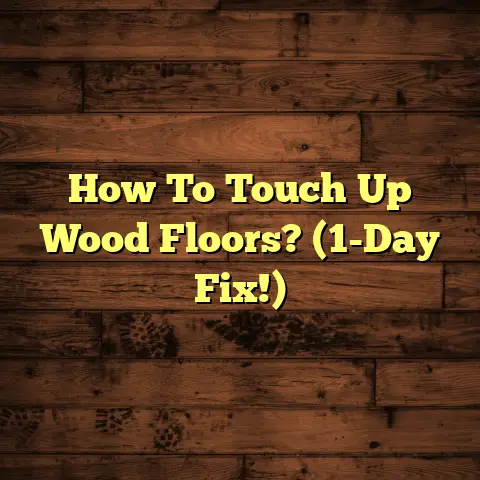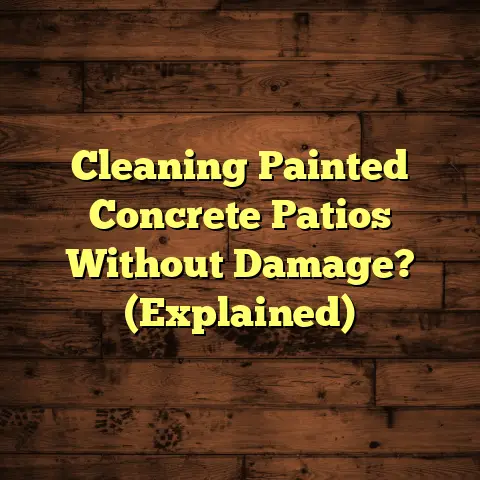Identifying Water Damage On Wood Floors: Key Signs?
Wood Floors: Key Signs
Imagine this: You step into your cozy living room, the sun streaming through the large bay window, casting warm light on your beautiful hardwood floors.
The wooden planks, polished to a sheen, have always been the centerpiece of your home, exuding warmth and elegance.
Suddenly, you notice a small, dark stain creeping along the edge of a floorboard, and your heart sinks.
Is that water damage? What does it mean for your beautiful floors?
You bend down to inspect the floor closely, and as you do, you catch a whiff of something musty—an unmistakable sign that something may be amiss beneath the surface.
This article will take you through the vital signs of water damage on wood floors, equipping you with the knowledge to identify the problem early and prevent further issues.
1. Understanding Water Damage
As a flooring contractor for over 15 years, I’ve seen firsthand the devastation water damage can cause to wood floors.
It’s not just about the cosmetic issues; it’s about the structural integrity of your home.
Definition of Water Damage
Water damage, in the context of wood floors, refers to any alteration or deterioration of the wood caused by excessive moisture exposure.
This can range from minor discoloration to severe warping and rot.
The extent of the damage depends on the amount of water, the duration of exposure, and the type of wood flooring you have.
Common Causes of Water
Damage in Wood Floors
So, what are the usual suspects when it comes to water damage? Here are a few:
-
Leaks: Plumbing leaks (under sinks, behind toilets), roof leaks, and appliance leaks (dishwashers, washing machines) are common culprits.
-
Flooding: Natural disasters like heavy rains or burst pipes can lead to significant water intrusion.
-
Humidity: High humidity levels, especially in basements or poorly ventilated areas, can cause moisture absorption over time.
-
Spills: Everyday spills that aren’t cleaned up promptly can seep into the wood and cause damage.
-
Pet Accidents: Pet urine, if left untreated, can penetrate the wood and cause stains and odors.
Did you know that according to the Environmental Protection Agency (EPA), indoor humidity levels should be between 30-50% to prevent mold growth and water damage? EPA Indoor Air Quality
2. Key Signs of Water Damage
Alright, let’s get down to the nitty-gritty. How do you actually spot water damage on your wood floors?
Here are the key signs I always look for:
Discoloration and Stains
Discoloration is often the first visible sign. It’s like the canary in the coal mine for your floors.
Explanation of How Water
Affects Wood Color
Water changes the wood’s chemical composition, leading to changes in its color. This is because water reacts with tannins and other compounds in the wood.
Examples of Different Types
of Stains (White, Dark, etc.)
-
White Stains: These are often caused by moisture trapped under the finish. It’s like a cloudy film on the surface.
-
Dark Stains: These indicate that water has penetrated deeper into the wood, potentially leading to mold or rot. They can range from brown to black.
-
Grayish Stains: These can be a sign of prolonged exposure to moisture and may indicate the wood is starting to decay.
I remember one time, a client called me about white stains on their brand-new hardwood floors. Turned out, their humidifier was set way too high, causing condensation to seep into the floor.
Buckling and Warping
Buckling and warping are more advanced signs of water damage. They indicate that the wood has absorbed a significant amount of moisture and is literally changing shape.
Description of How Wood
Reacts to Moisture
Wood is hygroscopic, meaning it naturally absorbs and releases moisture from the air. When wood gets too wet, it expands.
Examples of How Buckling
Appears in Different Types of Flooring
-
Solid Hardwood: Planks will lift at the edges, creating noticeable ridges.
-
Engineered Hardwood: The top layer may separate from the core, causing bubbling or unevenness.
-
Laminate: The edges may swell and separate, creating a raised, uneven surface.
Cupping and Crowning
Cupping and crowning are specific types of warping that I see quite often.
They’re related to the way the wood planks are constructed and how they react to moisture.
Detailed Explanation of
These Phenomena
-
Cupping: The edges of the planks rise higher than the center, creating a concave shape. This is usually caused by excess moisture on the underside of the planks.
-
Crowning: The center of the planks rises higher than the edges, creating a convex shape. This often happens after cupping if the moisture source is removed and the planks dry unevenly.
Visual Indicators to Look For
To spot cupping, run your hand across the floor. If the edges feel higher than the center, that’s a telltale sign.
For crowning, the opposite is true – the center will feel higher.
Soft Spots and Cracking
Soft spots and cracking are serious signs of structural damage. They mean the wood has started to break down.
How to Test for Structural Integrity
Press down on the floor in suspected areas. If it feels spongy or gives way easily, that’s a soft spot.
Look closely for cracks along the grain of the wood or at the joints between planks.
Signs of Serious Damage
Beneath the Surface
If you find soft spots or cracks, it’s likely that the damage extends beyond the surface. There may be rot or mold growing underneath.
I had a client who ignored a small soft spot in their kitchen floor for months. When I finally pulled up the flooring, the subfloor was completely rotten and infested with mold. It was a costly repair!
Mold and Mildew Growth
Mold and mildew are not only unsightly, but they’re also a health hazard. They thrive in damp environments and can spread quickly.
Health Implications and
Visual Signs of Mold
Mold can cause respiratory problems, allergies, and other health issues.
Visually, mold often appears as black, green, or white patches on the floor or along the baseboards. It may also have a musty odor.
Importance of Addressing
Mold Quickly
If you suspect mold, it’s crucial to address it immediately. Mold can spread to other areas of your home and cause significant damage.
According to the Centers for Disease Control and Prevention (CDC), mold exposure can cause a variety of health problems. CDC Mold Information
3. Identifying the Source of
Water Damage
Finding the source of the water is just as important as identifying the damage itself. Otherwise, you’re just treating the symptoms, not the cause.
Common Sources of Water
Intrusion (Leaks, Flooding, Humidity)
We’ve already touched on some of these, but let’s dive a little deeper:
-
Plumbing Leaks: Check under sinks, around toilets, and behind appliances. Look for water stains, drips, or signs of corrosion.
-
Roof Leaks: Inspect your ceiling for water stains or discoloration. Check your attic for signs of leaks after it rains.
-
Flooding: If your home has flooded, thoroughly dry and disinfect all affected areas. Consider hiring a professional water damage restoration company.
-
Humidity: Use a dehumidifier to control humidity levels in damp areas like basements. Ensure proper ventilation in bathrooms and kitchens.
Signs That Help Locate the
Source (e.g., Plumbing Issues, Roof Leaks)
-
Water Stains on Ceiling: Indicates a roof leak or a plumbing issue in the floor above.
-
Dampness Around Pipes: Points to a plumbing leak.
-
Musty Odor: Suggests mold growth, which is often caused by a hidden leak.
-
High Water Bill: Could indicate a hidden plumbing leak.
I always tell my clients to be proactive. Regularly inspect your home for potential water sources. It can save you a lot of money and headaches in the long run.
4. Differentiating Between
Normal Wear and Water Damage
Not every imperfection on your wood floor is a sign of water damage. Sometimes, it’s just normal wear and tear.
But how do you tell the difference?
How to Assess if Damage is Due
to Water or General Wear and Tear
-
Location: Water damage often occurs in specific areas, like near plumbing fixtures or exterior walls. Wear and tear is usually more widespread.
-
Pattern: Water damage often has a distinct pattern, like stains or warping. Wear and tear is usually more random, like scratches or dents.
-
Age: Newer floors are less likely to show significant wear and tear. Older floors may have more imperfections due to age.
Visual and Tactile Tests for
Distinguishing the Two
-
Visual Inspection: Look closely at the affected area. Is there discoloration, warping, or mold? These are signs of water damage.
-
Tactile Test: Feel the area. Is it soft, spongy, or damp? These are also signs of water damage.
-
Scratch Test: Gently scratch the surface with your fingernail. If the finish comes off easily, it may just be wear and tear. If the wood underneath is damaged, it could be water damage.
I had a client who was convinced their entire floor was ruined by water damage. After inspecting it, I realized it was just years of accumulated scratches and scuffs. A simple refinishing job made the floor look brand new.
5. The Impact of Time on Water Damage
Time is of the essence when it comes to water damage. The longer you wait to address it, the worse it will get.
The Progression of Damage if
Left Untreated
-
Initial Stage: Minor discoloration or staining.
-
Intermediate Stage: Buckling, warping, and soft spots.
-
Advanced Stage: Rot, mold growth, and structural damage.
Importance of Early Detection
and Intervention
Early detection and intervention can save you a lot of money and hassle. If you catch the problem early, you may be able to repair the damage yourself or hire a professional for a relatively inexpensive fix.
If you wait too long, you may have to replace the entire floor.
According to the Institute of Inspection, Cleaning and Restoration Certification (IICRC), water damage restoration should begin within 24-48 hours to prevent mold growth. IICRC
6. Case Studies
Let’s look at some real-life examples of water damage scenarios I’ve encountered over the years.
Real-Life Examples of Water
Damage Scenarios
-
Case Study 1: The Hidden Leak: A homeowner noticed a musty odor in their bathroom. After investigating, I found a slow leak under the toilet that had been going on for months. The subfloor was completely rotten and had to be replaced.
-
Case Study 2: The Flooded Basement: A heavy rainstorm caused a basement to flood. The water sat for several days before the homeowner realized what had happened. The hardwood floors were severely warped and had to be removed.
-
Case Study 3: The Appliance Malfunction: A dishwasher leaked overnight, causing water to seep into the kitchen floor. The homeowner caught it early and was able to dry the floor and prevent significant damage.
Analysis of How the Damage
Was Identified and Addressed
In each of these cases, early detection was key. The homeowners who caught the problem early were able to minimize the damage and save money on repairs.
The ones who waited too long faced more extensive and costly repairs.
7. Conclusion
Water damage is a serious threat to wood floors, but it’s not insurmountable. By knowing the key signs and acting quickly, you can protect your investment and keep your floors looking beautiful for years to come.
Summary of the Key Signs to
Watch For
- Discoloration and stains
- Buckling and warping
- Cupping and crowning
- Soft spots and cracking
- Mold and mildew growth
Importance of Vigilance in
Maintaining Wood Floors
Regularly inspect your floors for any signs of water damage. Address any issues promptly. And don’t hesitate to call a professional if you’re unsure about something.
Your wood floors are a valuable asset. Take care of them, and they’ll take care of you.





